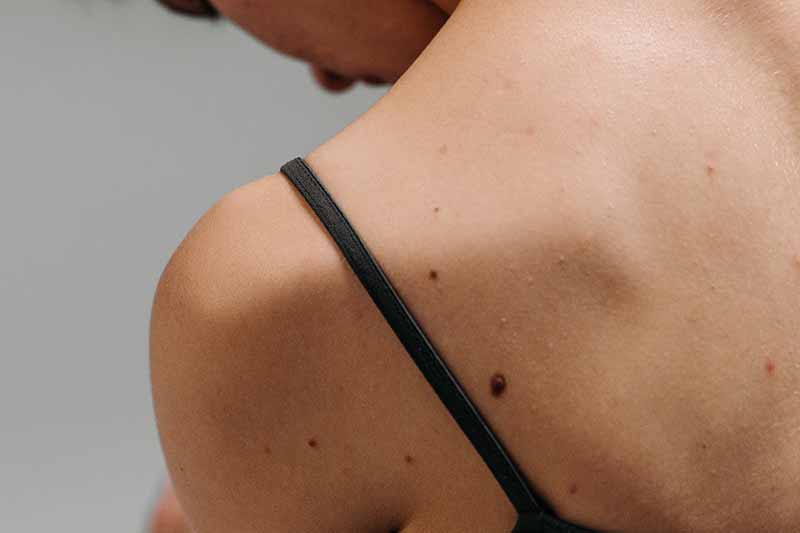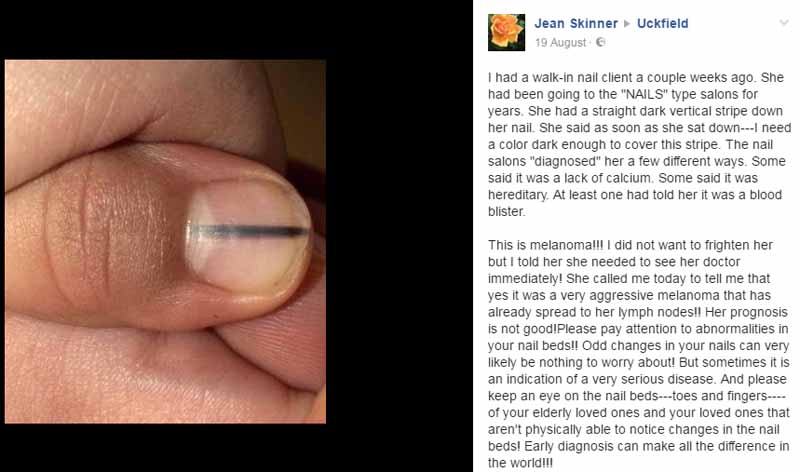
One of the keys to surviving skin cancer – as with most cancers – is early detection. A spa service provider could save a life by knowing what to look for. Some signs of skin cancer you should recognize.
Skin cancer is one of the most common types of cancer in the world and, according to cancer.net, the most common type of cancer in the United States.
There is more than one type of skin cancer, including (but not limited to) basal cell carcinoma and squamous cell carcinoma, of which an estimated 5.4 million cases are diagnosed annually in the US, and melanoma, the scariest and most dangerous form, of which there are about 100,000 cases diagnosed annually in the US, and 350,000 globally. About 80% of non-melanoma skin cancers are basal cell carcinoma.
It’s important to note, however, that because non-melanoma skin cancer is so common and most often curable, statistics are rough estimates, as individual cases are not usually reported to cancer registries. About 2,000 people die in the US each year from basal cell carcinoma.
The role spa service providers play in skin cancer detection
One of the keys to surviving skin cancer – as with most cancers – is early detection. And one of the things that makes this difficult is that there are large areas of our bodies that we simply can’t see or don’t look at very often.
This is where spa service providers may come in. If you know what to look for and how to address a situation, industry workers can save a life.
We discussed this topic a few years ago when a story emerged on social media about a nail technician who spotted a dark line under a client’s thumb. The customer had been told it was nothing to worry about but the tech urged her to seek another opinion, as she thought it looked like melanoma. She wrote:
“This is melanoma!!! I did not want to frighten her but I told her she needed to see her doctor immediately! She called me today to tell me that yes it was a very aggressive melanoma that has already spread to her lymph nodes!! Her prognosis is not good! Please pay attention to abnormalities in your nail beds!! Odd changes in your nails can very likely be nothing to worry about! But sometimes it is an indication of a very serious disease. And please keep an eye on the nail beds—toes and fingers—-of your elderly loved ones and your loved ones that aren’t physically able to notice changes in the nail beds! Early diagnosis can make all the difference in the world!!!”

Well, a similar story recently emerged that, while it doesn’t involve a spa service, reminded us of the importance of this subject.
Woman was told black mole on her scalp was nothing to worry about
In the more recent case, British journalist, Sarah Lee, reportedly noticed a black mole on her scalp that she was initially told by a dermatologist “looked fine.”
Lee first noticed the pea-sized mole in July 2021 when she took a photo of her scalp to see how dark her roots were. She got a referral to a dermatologist who told her the spot “looked fine,” that, at 29, she was too young for skin cancer, and that it was almost impossible to get melanoma on the scalp because hair blocks the sun’s ultraviolet rays.
Adam Friedman, a dermatologist who did not treat Lee told TODAY that these statements are false.
Lee’s general practitioner later told her the spots were a fungal infection. Both doctors were very wrong.
Lee later noticed satellite moles appearing around the first mole and eventually got the diagnosis of stage 3 malignant nodular melanoma. She needed surgery to remove the tumors and to scrape the tissue off down to the bone of her skull where it had grown. Doctors also removed 24 lymph nodes in the left side of her neck where the cancer had spread. She now is taking targeted therapy for a year.
The cancer would have been detected earlier if someone had taken Lee seriously. And it’s with that in mind that we are revisiting the topic of possible signs of skin cancer, so spa service providers know them when they see them.
In a 2019 interview, Susan Boiko, a San Diego dermatologist and spokesperson for the Skin Cancer Foundation, told us that “different” is a key indicator.
She explained: “Different doesn’t always mean bad, it just means different. You can see pictures of common skin cancers on the Skin Cancer Foundation website, but in my long career as a dermatologist I have seen cancers that don’t look like those typical pictures. So, the most important thing is something that is different.”
For example, if you see a client regularly and notice a mark that was not there before or is changing over time, that is something to note – anything that wasn’t there before or is evolving or changing.
Other potentially concerning signs as listed by Dr. Boiko and on the Skin Cancer Foundation website, are as follows:
Bleeding: Dr. Boiko said, “One thing that is really a waving red flag is something that is bleeding. If you see something that is bleeding that is a sign that someone should see their doctor.”
Asymmetry: Dr. Boiko said, “If you cut the spot out and folded it over, one half would not match the other,” then this can be a cause for concern.
Irregular border: If it is not clear where the border begins and ends and the border is not smooth, that is a sign to check it out. Skin cancers tend to have unclear borders, as well as scalloped or notched borders, while regular moles have smooth borders.
Unusual color: “It could be black, brown, pink, red, white, it could even look like a scar,” said Dr. Boiko. But varied shades of black or brown may be first signs of melanoma, and as the cancers progresses, red, white, or blue may appear. Benign moles are usually one or two shades of brown.
Larger diameter: Something bigger than a pencil eraser can be a bad sign. “I have seen skin cancers that are smaller than a pencil eraser. But if something is getting bigger, you want to get it checked,” said Dr. Boiko.
Darkness: Melanomas are often darker in color compared to normal moles. As noted above, however, they can also be lighter in color or pink. And rare, amelanotic melanomas are colorless.
Dr. Boiko also said that, while there are lots of reasons why a person could have a dark stripe under their nail, some of which are nothing to worry about, it could also be melanoma. “This is clearly abnormal. It stands out and is different,” she said at the time.
Spa service providers can play a crucial role in skin cancer detection
Spa service providers and hair stylists can play a crucial role in detection of skin cancers. As we stated above, we don’t see many areas of our bodies, including our scalps and backs. So, people might not know these marks are there.
Dr. Boiko told us, “the ability to see that something is different and to bring it to the attention of the client is the most important skill.”
She has been sent patients by both hairdressers and spa workers, she said. “I always tell someone who has been sent to me because of a hairdresser or massage therapist that they should reward that person and let them know how appreciative the doctor is that they were able to find that spot.”
Don’t frighten the guest unnecessarily
But be careful. You don’t want to scare someone unnecessarily or make an armchair diagnosis. It’s not the place of the service provider to say something “looks like cancer” or even looks unhealthy. What you should do is tell them it looks different and recommend they speak to a doctor. Dr. Boiko suggests taking a picture so the doctor can easily find the spot.
“Don’t take it super close. Take it in a way that we can see where the other landmarks on the body are. That is very helpful when the person comes to my office and then I can easily locate where the problem is.”
Do speak up. Recognizing the signs could save a life.
Spa Executive is published by Book4Time, the leader in guest management, revenue and mobile solutions for the most exclusive spas, hotels, and resorts around the globe. Learn more at book4time.com.



